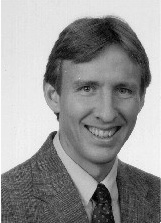

Todd Hubing,
Associate Editor
You know how sometimes your mind wanders and it’s hard to focus so you jump from one idea to another and you can’t seem to complete a thought so you have to … um…. I’m having one of those days, so this column is kind of a hodge-podge of thoughts and observations.
The 1998 IEEE EMC Symposium in Denver was incredible. There were more than 2600 attendees, yet everything appeared to run very smoothly. Barry Wallen and his committee put on a great show and the technical program was excellent. If you were unable to attend, but you are a member of the IEEE EMC Society, you will get a copy of the two-volume symposium record in the mail. Be sure to review it. There’s a lot of exciting progress being made that is (or should be) affecting the way EMC engineers do business.
I also had an opportunity to attend EMC’98 in Rome, Italy this year. This was another excellent technical meeting. Professor D’Amore and his colleagues at the University of Rome “La Sapienza” and the University of L’Aquila did a great job of organizing this symposium. There is a lot of good work being done in Italy and throughout Europe, particularly in the area of computer modeling techniques applied to EMC problems.
Limericks! Have you noticed that most limericks are about sex? Have you noticed that sex is incredibly popular around the world? We can only conclude that limericks must be great advertising! We need to start writing EMC limericks if we are ever going to get our message out. Here’s one:
There once was a man from Nantucket
Who slept in a very large bucket.
‘Twas lucky for him
He grounded the rim
For one stormy night lightning struck it.
Or, how about:
A woman from Europe’s Community
Saw an EMI-fix opportunity.
She built her box
With optical clocks,
Now her big problem’s immunity.
If you’ve got an EMC limerick, send it in! We’ll put them on the EMC Society web site. They’re not difficult to write. In fact, I’m thinking of asking that all future chapter activities be submitted to the newsletter in limerick form.
Greeting Cards! The holiday season is almost upon us. Have you got holiday greeting cards for your EMC co-workers? It’s hard to find EMC-specific greeting cards in the Hallmark store, but if you make your own cards you can personalize your message. Here’s an example of the type of holiday greeting card I would like to receive:
Season’s Greetings! Season’s Greetings!
Cancel all your status meetings
Deck the lab with copper coils
Ferrite beads and shiny foils
May your wit and perseverance
Squelch all EM interference
May your products be compliant
And your Christmas bonus giant.
Of course, if you’re the department manager and your card is for the company’s senior EMC engineer, you might want to personalize it a little more:
All throughout the corporation
You have got a reputation
I hear all the people say
You’re an EMC gourmet
When there is a complication
You address the situation
Taking steps without delay
You make problems go away
Now we have a situation
With our new configuration
You’ll be working Christmas day
Hope it’s happy anyway.
Here’s a card I wrote for a company product manager:
Your new product is astounding
But it lacks sufficient grounding
You have wires where you need straps
You need more decoupling caps
There are unused inputs floating
Cracks in your conductive coating
And the way you’ve gapped your plane
Makes me wonder if you’re sane
Though your product’s really crappy
Hope your Holiday is happy!
Whether or not your products are passing, I hope you have a great holiday season!
Many thanks to Vil Arafiles for submitting the following report of the activities of the Baltimore chapter.
The Baltimore-Annapolis EMCS Chapter conducted two technical meetings for 1998 at the Fort Meade Officer’s Club, Mapes Road, Fort Meade, Maryland. The first meeting was on April 7, 1998, where Mr. Jerry Hodges, Technical Director of the Joint Spectrum Center presented a paper on “Spectrum Related Changes.” He provided data relating to the real cost of the much publicized spectrum auction by the government. While it is true that the auction resulted in bids totaling billions, the cost of replacing or modifying government equipment to move out of the affected frequencies were estimated to be from two to five times the auction revenues. A total of 21 members attended the dinner and presentation.
A second technical meeting was held September 8, 1998, with Mr. John Osburn, Principal Scientist for EMC Test Systems presenting a tutorial paper on “EMC Antennas and Characteristics”. Mr. Osburn covered and explained the characteristics of antennas that are important in the EMC field. For instance, the relationships between receive and transmit antenna factors and how these terms relate to classical antennas and propagation equations. Attendees welcomed the presentation positively and at least four requested IEEE membership applications.
During the last meeting, the chapter members resolved to provide full support to the IEEE 2000 International Symposium on Electromagnetic Compatibility in Washington, D.C. We will be assisting Dr. William Duff, the Chairman of the Year 2000 EMC Symposium. This item was presented by the Chapter Vice Chair to the September 14, 1998 IEEE Baltimore Section Executive Committee meeting. The section agreed to provide full cooperation and support to this effort.
The Central New England chapter organized an EMC Technology session for the ELECTRO 98 Conference held in Boston on June 9-10,1998. The session was organized and co-chaired by John Luchini and John Clarke. Nine papers were presented by the following speakers: “Noise Filtering on Cables” by Lee Hill of Silent Solutions, “Follow These 18 Rules for Better EMC Design” by Jon Curtis of Laboratory for EMC, Safety, NEBS, SEMI-S2 and Telecom, “EMC Testing: For Some, It’s Mandatory-Why Not Do it the Most Cost-Effective Way and Get Some Added Benefits as Well?” by Michael Hopkins of KeyTek, “Radiated Immunity Testing: Avoiding Costly Errors and Investments” by Tim D’Arcangelis of Antenna Research Associates, Inc. “Measurement of Potential Magnetic Field Interference with Implanted Cardiovascular Defibrillators or Pacemakers” by J Robert Ashley, “Power Lines, Cancer, and Errors in Engineering Physics” by J Robert Ashley, “The European Union Machinery Directive 89/392/EEC: Removing the Mystery” by Jill Geppert of TUV Product Service/TUV Management Service, “Understanding the EMI Requirements of Bellcore’s GR-1089 Nebs Generic Requirement Specific Specification” by Greg Sperun of Bellcore, and “Mutual Recognition Agreement (MRA) with the USA and EU: Background and Current Status” by Butch Sarma of Technology International Inc.
The May meeting of the Orange County Chapter of the EMC Society featured Donald Bush of dBi Corporation speaking about PCB Design. Mr. Bush presented many helpful hints on proper printed circuit board design. His insights were well received by the more than twenty attendees.
At the July meeting, Chris Kendall of CKC Labs spoke on WorldWide EMC Regulations. Chris was kind enough to stop by on one of his many visits to his Brea test site. This is a topic of increasing concern for more and more EMC engineers with companies putting more emphasis on serving a global marketplace. Chris described the policies and procedures for meeting EMC requirements in many of the major countries such as Australia, Taiwan, South Korea, Hong Kong, etc. It was a very informative and interesting topic as determined by the excellent attendance of over twenty-five attendees.
The chapter meetings are fast becoming noted for the fine buffet that Randy Flinders arranges each time. Anyone hungry for another shark-kabob! Kudos are to be extended to Randy Flinders, Dan Modi and Ed Nakauchi for reviving the Orange County Chapter after a hibernation of about two years. Meetings are normally held on the second Thursday of every other month.
The EMC chapter is running a strong program again this year. No chapter meetings were held during July and August. Instead in July we supported the Oregon Section Summer Cruise (which was wonderful once again!). In August we ha excellent local turnout to the EMC Society International Symposium held in Denver, Colorado. Next year it will be held in Seattle, Washington.
Our recently elected officers are:
Chairman - Henry Benitez
Vice Chairman - Ed Blankenship
Secretary - Charlie Tohlen
Treasurer - Dan Arnold
Communications Director - Nora Xiao
Membership Services Director - Jerry Page
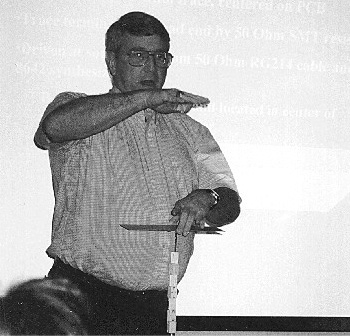
Bob Dockey of Hewlett-Packard in Vancouver, WA is
shown demonstrating
new techniques to reduce PCB common mode radiation at the
Oregon and SW Washington September Chapter meeting.

Henry Benitez of Tektronix, David Campbell (Portland Spirit Captain), and Bruce Brunstad of Tektronix.
Bob Dockey from Hewlett Packard jump started our Fall program September 30th with an exciting talk on “New Techniques for Reducing Printed Circuit Board Common-Mode Radiation”. The Buster’s Bar-B-Que provided at the meeting was of course a big hit as well. We held a 4 hour free EMC Design workshop with Chris Kendall on October 27 in Vancouver, Washington. This was an excellent value and a good way to entice more SW Washington participants. (Don’t worry Ghery, we are not encroaching on the Seattle chapter territory!). For our November chapter meeting, we have Dr. Howard Johnson to speak on “Why Digital Designers Don’t Believe in EMC!” The Oregon & SW Washington Chapter and Seattle chapter are once again coordinating monthly chapter meetings. This has been a great way to reduce the costs for speakers and be most efficient with speaker schedules. The two chapters have also been alternating EMC Colloquium events each year. Portland will have another Colloquium in April 1999. The exact date and program will be set soon.
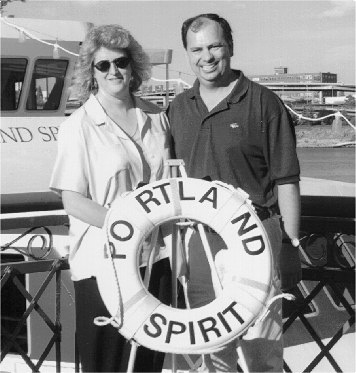
Jackie Benitez and Henry Benitez at the Oregon Section Summer Cruise
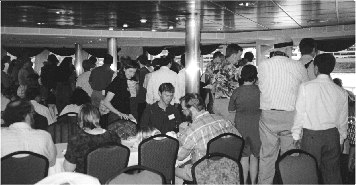
The IEEE Inter-Chapter Dinner Cruise was well
attended by Oregon and SW Washington chapter members.
The Keynote speaker was the President of IEEE USA.
Thanks to Barry Wallen, Chair of the 1998 IEEE EMC Symposium Committee, for submitting the following report.
The Rocky Mountain Chapter had a very successful Chapter meeting in August. We invited about 2600 guests and all of them showed up. We are of course talking about the 1998 EMC Symposium held in Denver. By all accounts it was a very well received event. I would like to thank all of the attendees, our faithful exhibitors, volunteers, and most of all the Denver Symposium Committee for making this a great event.
In August, the Chapter held a summer social event at Northwest EMC’s new open area test site in Sultan, WA. While Sultan may seem “out in the boonies” to you, in fact it’s just 60 minutes north of Seattle. Northwest EMC treated the chapter members and their families to an outdoor barbecue picnic with all the trimmings. The mouthwatering steak was especially memorable! A tour of a facility was also available for those not interested in playing Frisbee or enjoying the afternoon sunshine.

While at the Pike Place Market, Bob Dockey stopped to buy fresh flowers for his wife. (What a guy!)
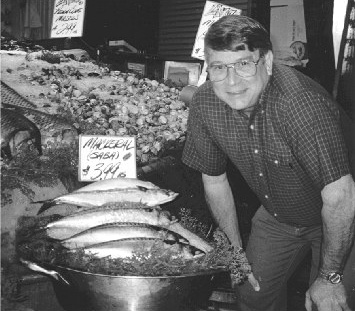
There’s something fishy about this photo!
That’s Bob Dockey checking out the fresh fish at the
Pike Place Market in Seattle the day following his presentation at the Seattle EMC Chapter
meeting.
In September, the Chapter hosted EMC Society Distinguished Lecturer Bob Dockey. Bob’s presentation was entitled “Reducing Printed Circuit Board Common-Mode Radiation.” Bob proposed several methods which can be used to effectively mitigate the common mode radiation mechanisms associated with printed circuit boards. As the EMC Engineering Group Manager at Hewlett-Packard in Vancouver, Washington, with over 25 years experience in EMC, Bob was certainly well versed on the topic. The day following the presentation, it was unseasonably sunny and warm in the Pacific Northwest so Bob spent a morning at the famous Pike’s Place Market in downtown Seattle. He marveled at the “flying fish” (see for yourself when you visit Seattle next year for the 1999 IEEE International Symposium on EMC) and then traveled to Portland where he was a speaker at that chapter’s meeting that night.
Kimball Williams reports that Dr. J. C. (Jim) McDade of Eaton Vorad in San Diego was the featured speaker at the July meeting of the Southeastern Michigan chapter. “EMC Concerns in Automotive Radar” was the topic of the meeting, which was held at the Eaton Corporation Innovation Center.
Automotive Radar engineers must execute their designs within limits imposed by both the FCC and the Society of Automotive Engineers (SAE). The former deals with the ability of the equipment to operate without interference among co-existing electronics systems. The latter is concerned with the ability of the equipment to continue to operate in a severe electromagnetic environment. The FCC has allocated frequency slots within the electromagnetic spectrum with limits on the power that may be radiated.
These restrictions set limits on the level of performance of the radar systems that can affect their effectiveness as collision warning systems (CWS) or automatic cruise control (ACC) systems. The author discussed the impact of FCC limits on system design. He also talked about interference problems with actual systems and the means by which they were mitigated.